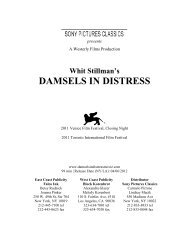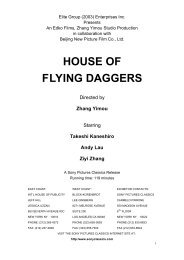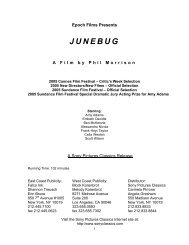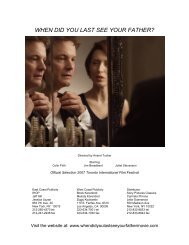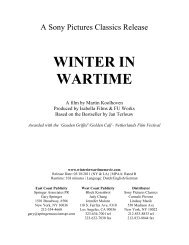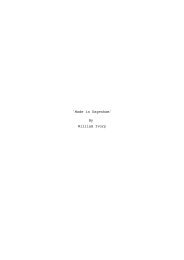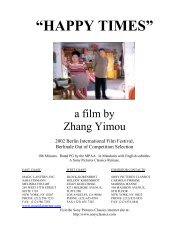You also want an ePaper? Increase the reach of your titles
YUMPU automatically turns print PDFs into web optimized ePapers that Google loves.
SUGARA <strong>Sony</strong> <strong>Pictures</strong> <strong>Classics</strong> releaseWritten and Directed by Anna Boden & Ryan FleckRunning Time: 114 minutesOfficial Selection: 2008 Sundance Film FestivalOfficial Selection: 2008 Toronto International Film FestivalEast Coast Publicity:Falco Ink.Shannon TreuschSteve Beeman850 7 th Avenue #1005New York, NY 10019Tel: 212-445-7100Fax 212-445-0623West Coast Publicity:Block Korenbrot PRMelody KorenbortJudy Chang110 S. Fairfax Ave, #310Los Angeles, CA 90036Tel: 323-634-7001Fax 323-634-7030Distributor:<strong>Sony</strong> <strong>Pictures</strong> <strong>Classics</strong>Carmelo PirroneLeila Guenancia550 Madison AvenueNew York, NY 10022Tel:212-833-8833Fax 212-833-8844
2SUGARCreditsFILMMAKERSDirected and Written byProduced byExecutive Produced byCinematographerEditorProduction DesignerCostume DesignerCastingMusic SupervisorMusic byANNA BODENRYAN FLECKPAUL MEZEYJAMIE PATRICOFJEREMY KIPP WALKERANNA BODENANDRIJ PAREKHANNA BODENELIZABETH MICKLEERIN BENACHCINDY TOLAN, CSALYNN FAINCHTEINMICHAEL BROOKCAST(In order of appearance)Alvarez JOSE RIJOAlfonso WALKI CUEVASMiguel ALGENIS PEREZ SOTOUmpire #1 SANTO SILVESTREReyes EMMANUEL NANITA CARVAJALPedro CESAR EMILIO MINAYA C.Marcos JOENDY BROWN PENASalvador KELVIN LEONARDO GARCIASanchez MARCOS ROSARudy KARL BURYErica ZAIDA ALEXANDRA HERNANDEZAbuela LILIN SOTO GONZALESLuis DIONI FELICIANOCarmen TEODOSIA SANCHEZ REYESSofia WALKY ALVAREZJaime LETILIER A. FOY, JR.Javier VICTOR MANUEL ADONFloor Manager RAUL ABRAHAMUncle Angel MANUEL CACHECousin Lupe GISSELLE JIMENEZPrima Omayra OMAYRA PEREZ SOTOAunt Lola FRANCIA TERESA ANDUJARCousin Felipe MICHEL JUNIOR SANCHEZ
3Neighbor Ana HERNY SEVERINOUncle Jeffe WILSON DANIELFrank BRAULIO CASTILLOJulio CONRAD LAYTONAntonio CARLOS FERMINJorge RAYNIEL RUFINOWaitress MARLA FINNBrad ANDRE HOLLANDOrlando GERARDO J. RAMIREZEd JESUS A. DIAZStu MICHAEL GASTONHelen Higgins ANN WHITNEYEarl Higgins RICHARD BULLAnne ELLARY PORTERFIELDHilary BARBARA P. ENGSTROMMichael LARRY E. DONALDSONClubby ISSAC THOMAS RICHER SMITHJack Jefferies RANDOLPH WEHOFERUmpire # 2 SCOTT BEHNJackass JONATHAN GREGOIREJeff BRANDON STEINBRECHERRandy BRANDON ROBERT GORRELLTravis IAN R. WILEYWendy HOLLY HANSONUmpire #3 TED TIMBROOKUmpire #4 DON UMLANDBatter CHRIS HARKINSReyna ALINA VARGASRafael J. EDDIE MARTINEZNikolai SANDOR TECSYRaquel KAROLINA WYDRAOsvaldo JAIME TIRELLICaballo RAFAEL ESPINALJosé JOSE LUIS ROMEROHamlet HAMLET ABREUJean JEAN CARLOS RODRIGUEZHarrison HARRISON ALVARADORoger ROGER PENAUmpire #5 RAMON CALDERON
4SYNOPSISSugar follows the story of Miguel Santos, a.k.a. Sugar, a Dominican pitcher fromSan Pedro De Macorís, struggling to make it to the big leagues and pull himself and hisfamily out of poverty. Playing professionally at a baseball academy in the DominicanRepublic, Miguel finally gets his break at age 19 when he advances to the United States’minor league system; but when his play on the mound falters, he begins to question thesingle-mindedness of his life’s ambition.The baseball academy where Miguel Santos has been training as a pitcher sincehe was signed at age 16 is a breeding ground for major league talent. Living at the facilityduring the week, players go through rigorous daily training, while scouts observe andgrade their abilities. Sugar’s uncommon ability on the mound is apparent, but there arethousands of teenagers across the island just like Miguel, all of whom hope for theopportunity to advance to the United States minor league system – just the first step ofmany on an arduous journey to the big leagues.Miguel spends his weekends at home, passing from the landscaped gardens andmanicured fields on one side of the guarded academy gate to the underdeveloped, morechaotic world beyond. In his small village outside San Pedro de Macorís, Miguel enjoysa kind of celebrity status. His neighbors gather to welcome him back for the weekend;the children ask him for extra baseballs or an old glove. To his family, who lost theirfather years before, Miguel is their hope and shining star. With the small bonus heearned when he signed with the academy some time ago, he has started to build hisfamily a new house – one that has a bigger <strong>kit</strong>chen for his mom and a separate room forhis grandmother.
5Towards the end of their winter season, Miguel is called up to spring training inthe United States – the next small step on his way to achieving his family’s dream of abig league contract. Family and friends come out of the woodwork to celebrate, andMiguel is on his way.Miguel travels with several other Dominican rookies to the team’s spring trainingfacility in Arizona. It’s his first time on a plane, his first time in a hotel room, his firsttime in a foreign land where a foreign language is spoken, his first time away from home.Miguel experiences a lot of firsts before he even sets foot on the enormous, immaculatespring training complex. Miguel quickly finds that he’s not the only superstar at springtraining; there are hundreds of highly talented prospects all trying to land spots on one ofthe team’s minor league affiliates, including Brad Johnson, the highly touted 2 ndbaseman, who landed a million-dollar contract out of Stanford. Despite this new level ofcompetition, Miguel proves himself exceptional on the mound even here, and lands a spotwith the Single-A affiliate in Bridgetown, Iowa – the Swing. Brad Johnson and JorgeRamirez, an old friend from the academy who was called up a couple years before, buthas been slowed down by a lingering leg injury, are among the other players placed onthe Swing.In Bridgetown, Miguel is assigned to a host family, the Higgins, an agingChristian couple who live in an isolated farmhouse. The Higgins are devout Swing fans,and every year they house a new young player from the team. They try to treat Miguellike part of the family, inviting him to dinners, bringing him to church, and evenencouraging a tenuous friendship between Miguel and their teenage granddaughter Anne.
6Jorge, the more veteran player and the only other Dominican on the team, alsotries to help Miguel learn the ropes. However, despite the Higgins’ welcoming effortsand Jorge’s guidance, the challenge of Miguel’s acceptance into the community isexposed in small ways every day, from his struggle to communicate in English to anincident of casual bigotry at a local bar.Miguel’s domination on the mound masks his underlying sense of isolation, untilhe injures himself during a routine play at first. While on the disabled list, Jorge – hisone familiar connection to home in this strange new place – is cut from the team, havingnever fully regained his ability following off-season knee surgery. The newvulnerability of Miguel’s injury, coupled with the loneliness of losing his closest friend,force Miguel to begin examining the world around him and his place within it. Pressuremounts when Salvador, a young pitching phenom who used to play with Miguel, isbrought up from the Dominican Republic to join the team. Miguel’s play falters, and theincreased isolation begins to take its toll on him. As his dream begins to fall apart,Miguel decides to leave baseball to follow another kind of American dream. His odysseyfinally brings him to New York City, where he struggles to find community and make anew home for himself, like so many before him.
7ABOUT THE PRODUCTIONFilmmakers Ryan Fleck and Anna Boden burst onto the independent film scene in2006 with their feature debut Half Nelson, a sensitively wrought drama that earned fiveSpirit Award nominations and brought its star, Ryan Gosling, an Academy Award ®nomination for best actor. With Sugar, the talented and audacious writing and directingteam has created another unexpected hero in Miguel “Sugar” Santos, a baseball hopefulwho journeys from a poverty-ridden village in the Dominican Republic all the way to aminor league farm team in the U.S. An unconventional look at one immigrant’s story,Sugar examines and redefines what it means to chase after the American dream.A lifelong baseball fan, Fleck thought he knew everything there was to knowabout the game. He knew that for decades the small island nation of the DominicanRepublic has been supplying American teams with some of their most talented players:home run hero Sammy Sosa, the Alou brothers, pitching greats Juan Marichal and PedroMartínez, and many more. But until a couple of years ago, he had no idea why. WhenFleck and his partner Anna Boden learned that the Dominican Republic is home totraining academies for every major league team in America, they were immediatelydrawn to the human side of the phenomenon. “We were less interested in the stories ofthe superstar Dominican players that we’ve all heard of,” says Fleck. “We wanted toknow the stories of the guys that you’ve never heard of and you never will hear of.”Sugar follows a talented young Dominican baseball player named Miguel on hisjourney to the United States to play for a minor league team in rural Iowa. “It’s not atypical story about someone trying to make good and lead the team to the championship,”notes Boden. “It’s about this particular person trying to adjust to a totally new world. It’s
8a new take on the immigrant experience, with the hero ending up in a small town in Iowainstead of moving to a big city with a large immigrant community.”In the Dominican Republic, where baseball has been popular for more than acentury, the sport is often seen as the quickest way for a man to lift himself and hisfamily out of poverty. An estimated 15 percent of major league players are Dominicanborn,making the Dominican Republic second only to the United States in producingmajor league ballplayers. Even more im<strong>press</strong>ive, more than 30 percent of players in theminor leagues, where up-and-comers are groomed for stardom, are from the island. Everyyear, hundreds of young hopefuls arrive at the academies eager to show their stuff toscouts from the U.S., but only a handful make it onto the rosters of major league teams.“I think this is going to open a lot of people’s eyes to an aspect of the gamethey’re not familiar with,” says Fleck. “At the same time, it’s also a coming-of-age storyand a self-discovery story, and I think many people will be able to relate to thatexperience.”To research the film, Fleck and Boden began spending time in the DominicanRepublic getting to know the local baseball community. One of their first meetings waswith Junior Naboa. A former player, Naboa is now assistant general manager and directorof Latin American operations for the Arizona Diamondbacks. He works out of BaseballCity, the camp where most of the scenes on the island were shot.Naboa, who experienced the difficult transition to professional player firsthand,became the filmmakers’ initial window into the world of the baseball academies. Heintroduced them to current players, former players and academy officials and explainedhow aspiring players age 16 and over come to the academies to have their potential
9assessed. If they meet the academies’ stringent standards, they may be invited to stay foranywhere from a few days to a maximum of four weeks for further evaluation.“In that time, we have to decide if we like the kid and want to sign him or not,”Naboa says. The stakes are extremely high. If a player is signed to a contract, he typicallyreceives a bonus of about $20,000, a small fortune in an impoverished nation where theaverage yearly per capita income is less than $3,000.But even before kids reach 16, they are often caught up in the island’s vastbaseball training industry. “There are independent private facilities that work with youngplayers from an early age,” explains Boden. “Some coaches start training kids from LittleLeague age. Many kids go to school and then train in the afternoon, but others drop out ofschool at 12 or 13 to train full-time in hopes of achieving this nearly impossible dream.And if they don’t make it, they don’t have any sort of education to fall back on.”As Fleck and Boden listened to the stories of dozens of current and formerplayers, Miguel’s journey began to take shape on the page. “Although it’s ultimately apretty personal story about a very specific person and his journey, it came about throughthis accumulation of details of a common experience,” says Fleck.Once the script was ready, Boden and Fleck called Half Nelson producers JamiePatricof, Jeremy Kipp Walker and Paul Mezey.“They had put together a story that was honest,” says Patricof. “It’s not the storyof a poor boy that comes out of the ghetto and makes it to the major leagues. It’s aboutfollowing your dreams and your passions, and at the same time, always making sure thatthe goal you're chasing is a goal you really want. ”
10Mezey was similarly drawn to the film’s themes of self-discovery and identity.“It’s a different viewpoint on a story of immigration, and it’s also a story aboutunderstanding who you are as a person,” he says. “Miguel’s whole life is baseball. But hesuddenly realizes that this thing that he’s really good at, he’s not exceptional at. Oncethat’s stripped away, what do you do?”Mezey’s earlier films have included HBO Films’ Maria Full of Grace, as well asLa Ciudad and Our Song. Like Sugar, they were stories about the struggles of immigrantsand the working class. “I thought it was really important for us to represent Sugar’s worldas authentically as possible,” he says. “It’s an obligation we had as storytellers.”The baseball community responded to the filmmakers’ commitment toauthenticity with an outpouring of support and goodwill. “Everywhere we went, we’dhear ‘You’re telling our story,’ ” says Mezey. “And everybody along the way has reallywanted to help facilitate us in that.”With only a few exceptions, none of those cast as Dominican baseball players hadever acted before. To find an actor with the right combination of physical ability, driveand naïveté to play Miguel, the filmmakers auditioned more than 600 actors at castingsessions all over the U.S. and in the Dominican Republic. The filmmakers personallytoured local ball fields and interviewed hundreds of baseball players in the DominicanRepublic.“If we found someone interesting, we’d bring him in for a callback to read fromthe script,” says Boden. “A lot of them had no idea what they were doing, but their coachor manager had told them to come. Some of them thought they were going to be on PBS.
11We got really lucky and we found some amazing young people who were just so naturaland fun to work with.”It was from among a group of young men playing softball that the filmmakersspotted Algenis Pérez Soto, whom they eventually cast as Miguel.Like so many other Dominicans, Pérez had hoped to be one of the chosen fewwho are admitted to the academy. “Baseball is the most important sport in this country,”he says. “I played baseball until I was 20. Everyone wants to play baseball. Every fatherwants his children to have a chance to be the next Sammy Sosa or Pedro Martinez. It’s asport that can change your life in one day.”Pérez feels Sugar is a second chance to experience that life, albeit under differentcircumstances. “Because I never signed, it feels like a godsend. I was never in anacademy when I was a baseball player. Being in the movie, I met a lot of importantpeople, like José Rijo and José Cano. That didn’t happen when I was a baseball player,but it’s happening now.”Producer Jamie Patricof has high praise for Pérez and for the daunting processthat led the production team to him and the rest of the cast. “Finding the right Miguel waschallenging. In the States, everyone wants to be an actor; down here everyone wants to bea baseball player. My hat goes off to Ryan and Anna because they spent months doingresearch and casting. They had to see probably a thousand kids, stopping from town totown, from baseball field to baseball field and setting up a camera, which is not a normalthing down here. Americans don’t just stop you and say, ‘Can you audition for amovie?’”
12Pérez went through a rigorous training program before shooting began. He hadgiven up playing baseball seriously several years earlier, and when he did play, he was ashortstop and second baseman, never a pitcher. To help him learn the playing techniqueshe would need to portray a rising young star on the mound, the filmmakers brought in amajor league pitching coach who worked with Pérez for two months.Pérez also worked one-on-one with Dominican baseball legend José Rijo. One ofthe preeminent pitchers in Major League Baseball during the 1980s and 1990s, Rijo wasa three time All-Star and was named MVP of the World Series in 1990. “Algenis got therole not because he was a good pitcher, but because he is a good actor,” says Rijo. “Buthe’s also a good athlete, which made it easy for me. In the film, he looks like aprofessional pitcher. To have two months to do this role and to be this ready for it, he hasto be a gifted player.”One of the Dominican Republic’s best-known baseball players, Rijo was hired bythe Washington Nationals to head up a training academy on the island after he retired.When the filmmakers were looking for a consultant to help organize the players and theteams, Rijo was one of the first names that came up.In addition to his consulting role, Rijo also landed a part in the film as Alvarez,Director of the Kansas City academy. “He was so charismatic and charming, we had toput him in the movie,” says Fleck. “He had tons of great stories about when he playedbaseball. And he used to play for the A’s, my favorite team.”Rijo’s life is in some ways the quintessential Dominican success story. He startedplaying baseball when he was six years old. As a Little Leaguer, he was a member of theDominican National Team, and he signed with the Cleveland Indians when he was just
1315. José Rijo recalls a Dominican saying that you can only leave the island two ways: byswinging the bat or by throwing the ball. “The main reason we play is that we are poor,”he says. “We are desperate to leave the country and find a way to help our families. I wasthrowing a ball and I was throwing it well, because that was the only way I could help myfamily.”As tough as things are today for young players, Rijo says it’s a vast improvementon what he lived through. “When I first signed, there was nothing even close to this. Wewould just sign and go to the United States and start playing right away.”Rijo was thrilled at the chance to work on the film. “I thought the script for Sugarwas awesome when I first read it,” he says. “It’s about my life. And to be able to dosomething so different, to be acting and consulting for a movie, it was just an outstandingopportunity.”Manny Nanita, who played minor league ball for the Minnesota Twinsorganization in the late 1990s, was cast as Reyes, the head coach at the academy whereMiguel trains. Nanita was forced to retire as a player because of an injury and now worksat the Boston Red Sox academy. “I know what these kids are going through. I came backto the Dominican to try and keep playing, but that didn’t work out.”Like Miguel and most of his compatriots in the movie, neither Nanita nor Rijospoke much English when they arrived in the U.S. Writer-director Ryan Fleck says this istypical for young ballplayers from the Dominican Republic. “For most of them, thenumber-one problem is language. Specifically, ordering food and finding food. Theyusually eat at someplace like McDonalds, where there are pictures.”
14Even if a player is good enough and lucky enough to be sent to the States, hisfinancial future is far from certain. “Starting salaries in the minor leagues average around$1,000 per month,” says Fleck. “American players can get a significant signing bonus tooffset a few years of low pay, but Dominican players are often paid far less thanAmerican kids getting signed out of high school or college.”To lessen their financial burden and help them acclimate, many teams assignplayers to live with American host families during their first few seasons. While not allteams do this, Anna Boden says the filmmakers chose to set the story in a small townwhere this was the practice, “so that Miguel in the film would be able to experience thecommunity in a much more intimate way.”The Higgins family, who become Miguel’s surrogate family during his time inIowa, represent a composite of real families the filmmakers interviewed while developingthe script. “They’re baseball fans who have been doing this for years,” says Fleck. “Theyhave extra room in their house and they like to take care of the players, but their numberonepriority is seeing the team win.”Sugar was shot on location in the Dominican Republic, Arizona, Iowa and NewYork City.After initial scouting in the Dominican Republic, the filmmakers were convincedthe island’s unique atmosphere and culture could not be replicated in another setting.“Even though this isn't really a baseball film, baseball is one of the underlying themes, soevery part of the baseball has to be accurate,” says Patricof. “In the Dominican Republic,we could shoot at a real academy. The players on our team are all players formerly signed
15to the academies; the coaches are real coaches. We hired a baseball consultant who couldwatch every play to make sure that we were never cheating.”Still, shooting in the Dominican Republic presented the filmmakers with someunique challenges. Accustomed to the clockwork efficiency of U.S. production teams, thefilmmakers had to adjust to the island’s more languid pace. “Things are a little bit morefluid in the Dominican, in terms of schedules,” says producer Paul Mezey. “But I thin<strong>kit</strong>’s kind of good for everyone to slow down a little bit. Sometimes when everything runslike a machine, you don't have the opportunity to discover things.”Among the surprises the filmmakers encountered were chickens, cows and goatsroaming the outfields of community ball fields. Also, because the Diamondbacksacademy was fully operational during production, the crew had to work around theteam’s playing and practice schedule.“Any time you mount a production in another country there are always logisticalhurdles to get through,” says producer Jeremy Kipp Walker. “And the scope of this filmis large, with a lot of moving parts. We were dealing with baseball, opposing teams, lotsof extras, lots of props. But we had a really good team and a lot of them spoke Spanish,so the language barrier wasn’t too difficult.”Shooting on the tropical island presented director of photography Andrij Parekh,who previously worked with Fleck and Boden on Half Nelson, with unique opportunitiesas well as some difficulties. “There are things here you couldn’t shoot anywhere else andit was really important to capture those specific elements and locations,” he says. “On theother hand, working with the sun in the Dominican Republic was a huge challenge.Between 11:00 a.m. and 3:00 p.m. the light is incredibly strong and almost bleaches
16everything out. We were shooting mostly on baseball fields, so I couldn’t really cover theset with anything to block the sun. I prayed for clouds every morning. It’s really beautifulin the morning and really beautiful in the evening, but you can’t shoot the whole movie inthe morning or the evening.”Much of the shooting took place in the small town of Consuelo, just outside SanPedro. “We were initially introduced to the town because there is a ball field on theoutskirts where a lot of the kids come and play,” says Mezey. “We noticed a lot ofsimilarities between the story of Miguel and those of the kids who converge on the localfield to play softball and hardball. Then we started exploring the side streets of the townand found this beautiful street that became Miguel’s street.”Having a U.S. film production descend on their town was a novel experience forthe residents of Consuelo, notes Mezey. “At first, there was an incredible amount ofcuriosity and then an incredible amount of excitement. The community was verysupportive of us, and a lot of them actually appear as extras in the movie because the daybefore Miguel leaves for the United States, there’s a big party and the whole town comesout to celebrate.”Once the action in the film moves to the U.S., the filmmakers wanted to be just asaccurate in their depiction of life among minor league players. To find the home for theSingle-A team that marks the apex of Miguel’s career, they spent days driving aroundIowa. They eventually decided on Davenport, a small city on the banks of theMississippi.“The city and the team really embraced us,” says Patricof. “We used the uniformsand the stadium of the real team.”
17To graphically illustrate Miguel’s sense of dislocation when he arrives in the U.S.,cinematographer Parekh created contrasting visual styles for the different locations.“Miguel leaves a place of comfort for somewhere that is really strange and awkward forhim. We wanted the Dominican Republic to feel really natural, sort of pastoral. Arizonaand Iowa are more garish, with more neon and artificial lights. So I tried to give theDominican Republic a softer palette and Arizona and Iowa have a stronger, brighter,punchier palette. When he gets to New York, which has a sizable Dominican population,I returned to that more comforting palette we used when he was at home.”In New York Miguel begins to recover some of the joy that baseball brought tohim after he discovers a community of fellow former pros who play weekend baseball atthe real-life Roberto Clemente Ballfield in the Bronx’s Crotona Park.The filmmakers learned about this group during their research for the film, saysFleck. “It’s an amateur league that has a ton of former professional players. We wereshocked that there was this huge community of Latino players who were living in theBronx and playing in this league. Some are in their 20s, some in their 40s, and they arestill super-competitive, but they have a great time.”For the former baseball players involved in the film, Sugar has been a uniqueopportunity to illuminate the struggles and sacrifices of young men trying to join one ofthe most elite groups of athletes in the world while adjusting to a new country, cultureand language. “I’m sure when Americans go see a game and see Sammy Sosa, they thinkthat Dominicans are great baseball players who make a lot of money in the big leagues,”says Pérez. “What they’ll see here is the players who are up-and-coming, who areworking really hard to become something.”
18ABOUT THE ACTORSAlgenis Pérez Soto (Miguel “Azúcar” Santos)Algenis Pérez Soto was born in Quisqueya, Dominican Republic. He has been playingbaseball since he was nine. He was chosen for the lead role of Miguel Santos in AnnaBoden and Ryan Fleck’s film Sugar after an extensive casting search that spanned theUnited States and the Dominican Republic. Sugar is his film debut.Rayniel Rufino (Jorge Ramírez)Rayniel Rufino was born in the Dominican Republic and moved to New York City at theage of four. Rufino has appeared in such films as Liberty Kid, which won Best Film at theNew York Latino Film Festival, and 9 Digits. His poetry and musical works haveestablished him as a talented new voice in the New York artistic community.Andre Holland (Brad Johnson)Andre Holland has appeared in the films Miracle at St. Anna, directed by Spike Lee, andComing Soon, as well as the television series “Law & Order” and “The Black Donnellys”and the ABC pilot, “The News.” His New York theatre appearances includes a tour-deforceperformance in “Blue Door” at the esteemed Playwright's Horizons, in which heplayed four generations of ancestors and relatives; a three-person production of “TheTempest,” which was workshopped in Tuscany; plus “Much Ado About Nothing” and“As You Like It” at the New York Shakespeare Festival in Central Park. Holland trainedat the NYU Graduate Acting Program, where he received an M.F.A., and Florida StateUniversity, where he received a B.F.A. in Acting.Michael Gaston (Stu Sutton)Michael Gaston has appeared in over 20 films, including the upcoming Home withMarcia Gay Harden, Body Of Lies with Leonardo DiCaprio, Lonely Hearts, Stay, FarFrom Heaven, The Crucible and The Wedding Banquet. He also has had roles in manyTV dramas, including “Jericho,” “Blind Justice,” “Damages,” “Brotherhood,” “TheSopranos,” “Prison Break,” “Oz,” “Homicide: Life On The Street” and multiple “Law &Order” episodes. Gaston’s numerous on- and off-Broadway roles include "A Day in theDeath of Joe Egg" on Broadway (with Eddie Izzard).Jaime Tirelli (Osvaldo)A graduate of the American Academy of Dramatic Arts, Jaime Tirelli has been featuredin such films as Marathon Man, Carlito's Way and Fort Apache, The Bronx, although hemay be best known for his work as Hector the trainer in Girlfight. His other film creditsinclude House of the Spirits, director John Sayles’ Brother from Another Planet and CityOf Hope, The Ministers, Chapter 27, The Brave One, Definitely, Maybe, Santa Mesa, IBelieve in America, Yellow and Bella. On stage, Tirelli has appeared in "Chronicle of a
19Death Foretold" on Broadway, "In the Summerhouse" at Lincoln Center’s VivianBeaumont Theater, "Blade to the Heat" at the Public Theater and numerous plays for ThePuerto Rican Traveling Theater. His television work includes a recurring role in NBC's"Kidnapped" and various "Law & Order" episodes.José Rijo (Alvarez, Baseball Consultant)José Rijo, a highly touted pitching prospect from the Dominican Republic, broke into themajors with the New York Yankees in 1984 when he was only 18 years old, the youngestplayer in either major league at the time. Rijo pitched in the 1990 World Series for theCincinnati Reds, recording two victories, including a two-hitter in the fourth and finalgame. His performance earned him the World Series Most Valuable Player Award as theReds won their first championship in 15 years. He was a member of the National LeagueAll-Star Team in 1994 and led the league in games started in 1993 and 1994. Rijo alsoled the National League in winning percentage in 1991, and in both strikeouts andstrikeouts per nine innings in 1993. After fighting through many serious injuries duringhis career, Rijo marked his final season in 2002 with the Tony Conigliaro Award, givenannually to the player who best overcomes obstacles and adversity though the attributesof spirit, determination and courage.Ann Whitney (Helen Higgins)Ann Whitney has appeared in a number of successful films with some very distinguishedactors, starting with the John Hughes comedy classic Home Alone, in which she playedthe drugstore clerk opposite Macaulay Culkin. (Children still ask her if their toothbrushesare approved by the American Dental Association!) She played the Myoelectric ClinicDirector in The Fugitive with Tommy Lee Jones, was the Singing Lady in an episode of“Columbo” with Faye Dunaway, played a lawyer opposite Morgan Freeman in ChainReaction, and drew blood from Sandra Bullock and Bill Pullman in a scene from WhileYou Were Sleeping. She also appeared in “Murder Ordained” with Kathy Bates and inmultiple episodes of “Early Edition.”Richard Bull (Earl Higgins)Born in Zion, Illinois, Richard served three years in Army Air Corps during World WarII. He has appeared in various films, including: The Satan Bug and The Hour of the Gun,both directed by John Sturges, The Russians Are Coming, The Russians Are Coming andThe Thomas Crown Affair both directed by Norman Jewison, The Andromeda Strain,directed by Robert Wise, and High Plains Drifter, directed by Clint Eastwood. Richard’stelevision work includes four years as Doc on “Voyage to the Bottom of the Sea” andnine years as Nels Oleson in “Little House on the Prairie.” He appeared in HBO Films’Normal with Jessica Lange and Tom Wilkinson.Ellary Porterfield (Anne Higgins)
20Born in Bend, Oregon, Ellary Porterfield was discovered at a talent competition in LosAngeles in 2001. Her imitation of her seventh-grade teacher caught her future manager’seye and she was immediately signed. Since then, Porterfield has filmed three pilots. Shemade her feature film debut in The Prize Winner of Defiance, Ohio, starring JulianneMoore and Woody Harrelson. She played Moore’s daughter, Tuff Ryan, in the film.Porterfield splits her time between Oregon, Los Angeles and Durham, North Carolina,where she is a freshman at Duke University. In her free time, she enjoys attending herbrother’s high school basketball games, thrift store shopping, knitting and being aCameron Crazy.Alina Vargas (Reyna)Alina Vargas was born in Santo Domingo, Dominican Republic in 1979. Following in thefootsteps of her legendary musician father Wilfrido Vargas, she quickly became aDominican pop sensation. Her first film, Sanky Panky, was one of the highest-grossingDominican films in history.Kelvin Leonardo Garcia (Salvador)Kelvin Leonardo Garcia was born in La Romana in the Dominican Republic. Kelvin hasbeen playing baseball all his life and has developed into a major league pitching prospect.He is currently training in the hope of signing with a major league team and attendingtheir academy in the Dominican Republic. Sugar will be his film debut.Joendy Peña Brown (Marcos)Joendy Peña Brown was born in San Pedro de Macorís in the Dominican Republic, wherehe has been playing baseball since he was a child. Joendy frequently participates in hislocal church’s productions as an actor and singer. Sugar will be his film debut.
21ABOUT THE FILMMAKERSRyan Fleck and Anna Boden (Writers and Directors)Ryan Fleck and Anna Boden’s first dramatic feature film, Half Nelson, premiered at the2006 Sundance Film Festival and went on to win numerous prizes, including threeGotham Awards for Breakthrough Director, Actor, and Best Feature Film. The film alsoreceived two Independent Spirit Awards for its lead actors, Ryan Gosling and ShareekaEpps, and an Academy Award ® nomination for Gosling as Best Actor.Fleck and Boden have also collaborated on several short films and documentaries overthe past six years, including: Have You Seen This Man? (2002), Gowanus, Brooklyn(2004), and Young Rebels (2005).Boden also serves as editor and executive producer on Sugar.Paul Mezey (Producer)Paul Mezey is a New York based independent producer and founder of Journeyman<strong>Pictures</strong>. Mr. Mezey has produced a number of critically acclaimed films includingMaria Full of Grace which received a 2005 Academy Award Nomination for BestActress in a Leading Role and Half Nelson starring Ryan Gosling which received a 2007Academy Award Nomination for Best Actor in a Leading Role.Mr. Mezey produced Azazel Jacobs’ Momma’s Man which premiered alongside Sugar atthe 2008 Sundance Film Festival. Mr. Mezey recently wrapped production on thefilm Cold Souls starring Paul Giamatti, Emily Watson, and David Strathairn. Projectscurrently in development include David Riker’s The Girl starring Emily Blunt and JoshuaMarston’s upcoming feature The Fortress of Solitude, based on Jonathan Lethem’sNational Bestseller.Other films produced by Mr. Mezey include: Angel Rodriguez (HBO Films), EverydayPeople (HBO Films), Spring Forward (IFC Films), Our Song (IFC Films), The City (LaCiudad) directed by David Riker, Mississippi Blues documentary You See MeLaughin’ directed by Mandy Stein, and The Ballad of Ramblin’ Jack directed by AiyanaElliott, winner of the Artistic Achievement Award for documentary film at the 2000Sundance Film Festival.Mr. Mezey received the IFP/West Motorola Producer's Award at the Independent SpiritAwards in 2001 and was selected by Variety in 2004 as one of the "Ten Producers toWatch".
22Jamie Patricof (Producer)Jamie Patricof is the founder of Hunting Lane Films, a Los Angeles-based productioncompany. He is the producer of Half Nelson, which premiered in 2006 and went on towin three Gotham Awards and two Independent Spirit Awards. In addition, the star of thefilm, Ryan Gosling, was nominated for an Academy Award ® for Best Actor.Patricof is also the producer of Confessions of a Superhero, a documentary film directedby Matt Ogens, which was released theatrically in the fall of 2007. Prior to that heproduced Point & Shoot, which screened at the Tribeca and Hamptons film festivals andis now available on home video. Patricof is currently in pre-production on DerekCianfrance’s first feature film, Blue Valentine, which was the winner of the ChryslerMillion Dollar Film Project.Patricof was executive producer of the VH1 shows “Players: Ludacris” and “Run DMCand Jam Master Jay: The Last Interview,” a tribute to the seminal hip-hop group. He wasalso creator and executive producer of “The Life,” a 32-episode documentary series onESPN. This behind-the-scenes look at athletes’ lives off the field was nominated for anEmmy ® Award. Before entering the world of television and film, Patricof worked at RapSheet magazine and Def Jam Records in marketing and promotions. He also produced alive stand-up comedy show in NYC that featured Dave Chappelle, Mike Epps, ColinQuinn and many others.He lives with his wife and daughter in Los Angeles.Jeremy Kipp Walker (Producer)Jeremy Kipp Walker co-produced Ryan Fleck and Anna Boden's celebrated feature filmHalf Nelson, for which Ryan Gosling received a 2006 Best Actor Academy Award ®nomination. He is a partner in the New York City-based film production companyJourneyman <strong>Pictures</strong>, where his recent credits include Maria Full of Grace, EverydayPeople, You See Me Laughin' and Angel Rodriguez.Prior to joining Journeyman, Walker worked in production at Woody Allen's PerdidoProductions on the films The Curse of the Jade Scorpion and Hollywood Ending. Herecently produced the Moroccan-based thriller The Passage, which premiered at the 2007Toronto Film Festival. He is currently producing Cold Souls, written and directed bySophie Barthes and starring Paul Giamatti, David Strathairn, Emily Watson and DinaKorzun.Walker is an award-winning director in his own right, whose short films have screened atdozens of renowned film festivals, garnering top prizes at the Tribeca Film Festival, theAustin Film Festival, the Palm Springs International Film Festival, the New Orleans FilmFestival and the Rhode Island Film Festival.
23Andrij Parekh (Cinematographer)Of Ukrainian and Indian descent, Andrij Parekh studied cinematography at the FAMUFilm School in Prague and at NYU's Tisch School of the Arts, where he received hisM.F.A. in 2003. He was nominated for the 1998 Eastman Excellence in CinematographyAward, apprenticed on The Yards (2000) with Harris Savides (Gerry, The Game), and isa recipient of the 2001 and 2003 ASC Heritage Award for Cinematography.Andrij has shot 11 features to date, including Sonos de Peixe, (for director KirillMikhanovsky), August (for director Austin Chick), Noise (for director Henry Bean), HalfNelson and Sugar (for directors Ryan Fleck and Anna Boden). His films have played atmany international festivals, including Cannes, Sundance and Tribeca. Andrij was namedone of Filmmaker’s 25 New Faces of Independent Film, was included as one of Variety’s10 Cinematographers to Watch and featured in Hollywood Reporter’s “NextGeneration—Crafts” article. He is currently shooting and producing Cold Souls, withcreative collaborator and partner Sophie Barthes.Elizabeth Mickle (Production Designer)Elizabeth Mickle has worked as a production designer in the film and television industryfor six years. Her first feature film, Madness And Genius, directed by Ryan Eslinger,received critical acclaim at the Toronto International Film Festival, as well as anIndependent Spirit Award nomination. She was recognized for her design on the indie hitHalf Nelson and received the Hollywood Reporter's 2006 Next Generation Award in thefield of Production Design. She is currently designing Cold Souls, another Sundance FilmLab screenplay, by first-time director Sophie Barthes. Elizabeth currently lives in NewYork City.Erin Benach (Costume Designer)Erin Benach also collaborated with Ryan Fleck and Anna Boden on their previous film,Half Nelson starring Ryan Gosling for which he received an academy award nomination.In winter of 2007 she brought 1970's small town prostitution to Lori Petty's The PokerHouse starring Selma Blair and David Allan Greir. She is currently designing SophieBarthes’ Cold Souls, starring Paul Giamatti, Emily Watson, and David Strathairn. Erincurrently resides in Los Angeles, CA and Brooklyn, NY.Michael Brook (Music)Born and raised in Toronto, in the early 80s Brook worked as an engineer with DanielLanois. At this time, he also met musical iconoclast Brian Eno. Brook also invented theinfinite guitar, whose practitioners include U2's the Edge, Lanois and Brook himself. In1985, Brook's first solo album, Hybrid, with contributions from both Eno and Lanois,was released to great critical acclaim. His second solo album, Cobalt Blue, also featuredEno among its larger cast of musicians. In between his own records and film scores,Brook has produced a number of influential albums for Peter Gabriel's Real World label
24and collaborated with artists such as The Pogues, Bryan Ferry, Youssou N'Dourand Nusrat Fateh Ali Khan.Michael worked with the Edge of U2 on the soundtrack for the film Captive and in 1992he composed and performed the acclaimed score for the Academy Award nominateddocumentary The Fires of Kuwait. Following work on the soundtrack to director MichaelMann's 1995 film Heat, Peter Gabriel recommended Brook to Kevin Spacey to score hisdirectorial effort Albino Alligator, which led Brook to score Paul Schrader's 1998 featureAffliction. As a musician, Brook's electronically-enhanced guitar may be heard in manyfilms including Traffic and on Hans Zimmer's scores for Black Hawk Down, MissionImpossible 2 and The Pledge. Most recently, Brook composed the score for the Oscarwinning2006 film An Inconvenient Truth and Sean Penn's Oscar-nominated Into theWild. Brook also recently composed and produced the soundtrack for the highlyacclaimedmulti-media exhibition Ashes and Snow.Lynn Fainchtein (Music Supervisor)Lynn Fainchtein has provided her musical expertise to a range of media, including film,television, radio and journalism. She has worked as music supervisor and soundtrackproducer on such films as acclaimed Mexican filmmaker Alejandro Gonzalez Iñarritu’sBabel, 21 Grams and the Academy Award ® nominated Amores Perros, as well as MariaFull of Grace, directed by Joshua Marston and winner of the 2004 Sundance FilmFestival Audience Award. She has been music supervisor on all films produced byCanana Films, a production company founded by Gael Garcia Bernal and Diego Luna,including Deficit, Chavez, Cochochi, and Voy a Explotar.Her recent credits include Sin Nombre, X-mas, Inc., Push, Sólo Quiero Caminar, Don’tLet Me Down, and Violanchelo.Her other film credits include La Misma Luna and John Sayles’ Casa de los Babys.Fainchtein has been music supervisor for Altavista Films’ soundtracks and also served asthe company’s director of A&R.She is currently a writer for Rolling Stone magazine, reporting from Mexico. She waspreviously with MTV Latinoamerica, where she worked as Director of MusicProgramming and producer/writer/interviewer for MTV News. In radio, she has also beena host, DJ, producer, programmer and director at Mexican stations, including Rock 101,Dimension 1030 AM, Espacio 59 and Imagen 90.5 FM.Cindy Tolan, CSA (Casting)Cindy Tolan is a casting director for film, television and theatre. Her film credits includeThe Darjeeling Limited, The Namesake, Kinsey, Sherrybaby, Starting Out in the Evening,The Ballad of Jack and Rose, Personal Velocity, Loggerheads (also co-producer), Casade los Babys, Angela and the upcoming The Private Lives of Pippa Lee. Her Broadwaycredits include Ally My Sons, Xanadu, Avenue Q, A Year with Frog and Toad, and
Medea. Other theatre credits include Resurrection Blues (Old Vic, London). Among hertelevision credits are HBO’s “Flight of the Conchords”, “The Return of Jezebel James”,and the upcoming FOX series “Fringe”.25



